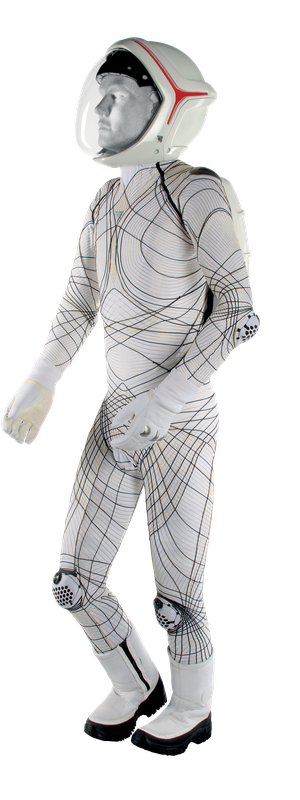Innovation Projects
Space Suits | Sea Guard | Concept 001
SPACE SUITS
PROTECTION
Dainese returns to space to revolutionize astronaut safety
INTERNATIONAL SPACE STATION, December 29th 2016 – Following the September 2015 IRISS Mission during which Danish astronaut Andreas Mogensen first tested SkinSuit, Dainese is returning to space protecting Thomas Pesquet, who has been on the Proxima Mission since November 17th.
The result of a partnership between the European Space Agency (ESA) and the Dainese Science and Research Center, and developed to be worn inside the International Space Station, SkinSuit provides “loading” in the head-to-foot direction, in effect recreating gravity’s load on Earth, but in a weightless environment. SkinSuit aims to counteract the stretching of the spine in space, producing large amounts of vertical load without compromising comfort and movement. SkinSuit is completely made-to-measure by Dainese, requiring that over 150 measurements of the astronaut’s body to be taken.
Dainese, which has always made protection in dynamic sports its mission, confirms its commitment to researching innovative solutions for the protection of humans and constantly looks to the future by exploring possible evolutions of the relationship between nature, art and science.
Dainese has in fact recently supported SACI, Studio Arts College International, in the symposium “From Galileo to Mars: Renaissance of the Artsciences”. The exclusive event took place November 12 in Florence, Italy, with distinguished guests including NASA Deputy Administrator Dava Newman; NASA astronaut, engineer and artist Nicole Stott; Italian astronaut Paolo Nespoli; architect and designer Guillermo Trotti and artist and professor Lia Halloran.
At the event, Dainese showcased its two space suits: SkinSuit and BioSuit. More specifically, BioSuit is a space suit intended for the first human journey to the Red Planet expected around 2030 that applies the “lines of non-extension” concept, being able to apply the necessary mechanic pressure to the astronaut’s body, although without compromising movement.
The Dainese design approach has always been inspired by nature and its structures, recognizing the importance that innovation works at the intersection of design, engineering and science, aiming for the ideal balance between effectiveness, weight and ergonomics. The latest technology resulting from this approach is called D-air®, the wearable airbag that today protects the human body in sports and which is being prepared for the mobility of tomorrow, toward Mars.
SKINSUIT
WHAT IS THE SKINSUIT?
The SkinSuit is a skin-tight garment made to be worn inside the International Space Station and has been developed together with the
Dainese Science and Research Center to provide ‘loading’ in the head-to-foot direction,
in effect recreating the load that gravity puts on all of us on Earth, but in weightlessness.
SkinSuit aims to counteract the stretching of the spine in space, which might be the cause of the lower back pain experienced by around half of astronauts in the early part of their missions.
The ability to control spinal elongation in space might also help reduce the risk of post-flight injury
to the spine’s intervertebral discs – commonly called a herniation or ‘slipped disk’ – which astronauts are at greater risk of experiencing when they return to Earth.
WHEN DID THE SKINSUIT GO TO SPACE?
Danish ESA astronaut Andreas Mogensen has been the first astronaut to evaluate the Skinsuit in space when working on the International Space Station for the 10-day IRISS Mission in September 2015. French Thomas Pesquet will wear Skinsuit during the upcoming Proxima Mission (November 2016).
HOW WAS THE SKINSUIT MADE?
Each SkinSuit has to be individually tailored and a professional tailor from Dainese took over 150 measurements of Andreas’ body.
Andreas’ body mass and height were also measured to further customize his SkinSuit.
The upper part of SkinSuit is made of a non-stretch canvas with internal padding, and the loading part that compresses the spine is made from a
material with a bi-directional elastic weave, producing large amounts of vertical load without being too tight around the legs and body.
HOW DID THIS PROJECT COME ABOUT?
The project is a collaborative effort between ESA`s Space Medicine Office, King’s College London’s Centre of Human & Aerospace Physiological Sciences,
the Massachusetts Institute of Technology’s (MIT) Aeronautics and Astronautics and Engineering Systems Department and University College London’s School of Pharmacy.
SkinSuit is the result of the partnership between ESA and the Dainese Science and Research Center.
Source: Blog.esa.int

BIOSUIT
WHAT IS THE BIOSUIT?
Starting from Arthur Iberall’s studies in the Fourties, it has been discovered that there are certain points of the body that, despite movements,
do not contract and do not stretch. By connecting these points through the so-called “lines of non-extention”, pressure remains constant.
BioSuit is designed to connect these points, being able to apply the necessary mechanic pressure to the body, although without compromising movement.
The news is exactly the replacement of pneumatic pressurization with mechanic one. The inside of astronaut’s suits, in fact,
in order for humans to survive in the vacuum of space, need to provide pressure.
The skintight suit allows for a degree of movement impossible in a gas-filled suit.
WHEN DID THE BIOSUIT GO TO SPACE?
BioSuit has not gone to space yet. BioSuit was born from one of NASA’s needs who, for the first human journey to the Red Planet expected around 2030, has set up a project to design a new space suit, lighter and more practical.
HOW WAS THE BIOSUIT MADE?
The lines of non-extension are represented by the red and black filaments that decorate the BioSuit prototype. The suit will be made of elastic material, but for all other features options remain open. For sure, BioSuit must guarantee to astronauts oxygen inflow, protect them from effects of prolonged microgravity, solar radiation and impacts with micro-meteoroids, although offering greater flexibility and finding the perfect balance with ergonomics and comfort.
HOW DID THIS PROJECT COME ABOUT?
Conceived by Dava Newman, MIT Professor and NASA’S Deputy Administartor, BioSuit has been designed by Trotti and Associates, owned by Argentinian space architect Guillermo Trotti, whereas the first prototypes are the outcome of the Dainese Science and Research Center’s know-how.
